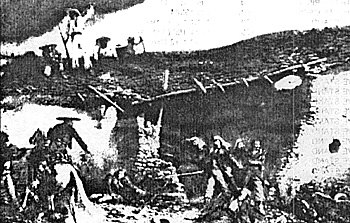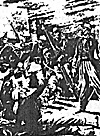 The small Mexican hamlet of Camerone lies on the old highway between the port of Vera Cruz and on the Gulf of Mexico and Mexico City. In 1863 with the construction of the new railroad barely begun, all transport had to travel along a narrow road corridor. French supply trains winding their way through the foothills of the Sierra Madre found themselves under constant threat of attack from Nationalist Mexican troops. French troops had to provide the convoys with protection along every foot of their 250 mile journey.
The small Mexican hamlet of Camerone lies on the old highway between the port of Vera Cruz and on the Gulf of Mexico and Mexico City. In 1863 with the construction of the new railroad barely begun, all transport had to travel along a narrow road corridor. French supply trains winding their way through the foothills of the Sierra Madre found themselves under constant threat of attack from Nationalist Mexican troops. French troops had to provide the convoys with protection along every foot of their 250 mile journey.
Two battalions of the Legion were detailed to guard this vital corridor between Vera Cruz and Puebla. Here, the land was low and swampy, characterised by close and stifling, heavy tropical vegetation. The Legionnaires set-up a string of blockhouses at strategic points along the route whilst the bulk of the remaining troops were eaten up in convoy protection duties.
On April 29th, Colonel Jeanningros Chef du 1st battalion, had been tasked to protect a bullion convoy leaving Soledad and headed for the French siegeworks at Puebla. The duty company of the Legion was the 3rd, which due to sickness had no officers and was down to 62 NCO`s and men. The Colonel`s adjutant Captain Jean Danjou volunteered to lead the company along with 2nd Lieutenants Maudet and Vilain also from the Colonel`s staff. Captain Danjou was a highly regarded veteran of the Crimea and Italy. He had lost his left hand in combat and in it`s place wore an articulated wooden one attached by a thick leather cuff to his wrist.
In the early hours of April 30th he led the 3rd Company out ahead of the convoy to ensure that the path was clear. The company advanced in two groups parallel to the road. Danjou and the company mules were in the centre and a small rearguard followed behind. Just before 7.am the company marched through the hamlet of Camerone, little more than a hacienda with farmhouse and outbuildings connected by a walled courtyard, whilst other tumbled down dwellings nestled nearby.
Interrupted Breakfast
A mile or so beyond Danjou called a halt for breakfast, but whilst the coffee was brewing a sentry saw the shapes of Mexican cavalry moving towards them. The alarm raised, the Legionnaires formed a hollow square as more and more horsemen appeared.
The Mexican cavalry were the outriders of a mounted force some 800 strong led by Colonel Milan, whose intention was to seize the French bullion convoy. The force he had assembled for this task was quite impressive - 500 'regular' Mexican cavalry armed with Remington and Winchester carbines, 300 irregular cavalry and 3 'battalions of Mexican infantry, consisting of 1,200 men. The infantry were barely more than conscripted peasants armed with a few rifles and plenty of old muskets.
Milan had raced ahead with his cavalry, leaving the infantry to follow as best they could. His men found Danjou`s company in semi-open terrain with waist-high grasses and clumps of tropical vegetation, unsuitable for co-ordinated mounted action. The first volleys from the Legionnaires Minnie rifles caused them to fall back and await the main body of cavalry.
 Danjou decided that the best course of action was to stage a withdrawal through the thickest of the vegetation to Camerone, where the company might be able to hold out till help arrived. Firing successive volleys, the hollow square fought a running battle with the cavalry through the cactus scrub back to the hamlet they had passed earlier that morning.
Danjou decided that the best course of action was to stage a withdrawal through the thickest of the vegetation to Camerone, where the company might be able to hold out till help arrived. Firing successive volleys, the hollow square fought a running battle with the cavalry through the cactus scrub back to the hamlet they had passed earlier that morning.
Whilst Milan couldn`t bring his whole mounted force to bear due to the unsuitability of the ground and vegetation, his men did manage to take a toll of 16 Legionnaires and worse still for the French, managed to run-off the mules carrying the rations and ammunition reserves.
Reaching Camerone
Reaching Camerone the 42 men and 3 officers of the 3rd Company found a semi-derelict two storey farmhouse or inn, set in a courtyard surrounded by collapsing walls, with a few dilapidated lean-to sheds arranged around the inside of it. In one corner was a substantial barn.
A party of Mexicans had beaten the Frenchmen to the hacienda and were installed on the upper floor of the farmhouse. A charge by the Legionnaires could not dislodge the Mexicans as there was no way to reach them on foot. So keeping the Mexicans in the house pinned down as best as possible, Danjou set about fortifying the courtyard.
Upon arriving at Camerone, Milan`s cavalry dismounted and made several attempts to rush the courtyard. Each rush was beaten back, the Mexicans hampered by their chaps, swords, heavy boots and spurs. Heavily outnumbering the small garrison, with more men on the way, Milan called for the French to surrender around 9 a.m. Danjou refused and made each and every legionnaire promise to fight to the end.
Throughout the day the Mexicans attacked incessantly. At 11 a.m. a shot from the farmhouse hit Danjou in the chest mortally wounding him. Lieutenant Vilain with grim determination took over directing the defence. At midday the situation worsened as the Mexican infantry of the mobile Vera Cruz, Jalapa and Cordova battalions finally made an appearance. The attacks were now pushed forward with more vigour, though to the experienced French they seemed spasmodic and uncontrolled.
Around 2 p.m. Vilain was killed and command fell to Lieutenant Maudet, now armed with a rifle. The number of wounded and killed amongst the Legionnaires meant that they could no longer keep the Mexicans, now reinforced from the windows of the farmhouse and their positions at the walls and in the lean-to`s came under heavy fire from this quarter.
Last Dozen
At 5 p.m. Maudet had only 12 men left standing. There was a further call to surrender, the reply to which has gone down in French military annals "Merde". There was a silent lull during which a Spanish-speaking Legionnaire could hear Colonel Milan haranguing his infantry massed behind the cover of some outhouses. Milan was heard to say that at all costs resistance must be crushed, and any failure would bring undying disgrace, so he was ordering a general assault. The Mexicans shuffled to their feet and made their most desperate effort of the day. The excellent shooting of the Legionnaires kept the Mexicans at bay for a moment, then suddenly they closed in, swarming into the courtyard through every gate, window and breach in the walls. A desperate struggle ensued in the south-eastern corner of the courtyard. Corporals Pinzinger and Magnin with Legionaries Kunasec and Gorski faced back to back and sold their lives as dearly as they could against the mass of Mexicans rushing them.
Maudet together with Corporal Maine and legionnaires Leonard, Cotteu, Wenzel and Constantin retained possession of the barn for a further quarter of an hour until the time came when there was just one round per remaining. Maudet ordered the round to be fired, then he placed himself at the head of his men and led the brave little band in a final desperate bayonet charge out into the sunlight of the courtyard.
Constantin died protecting Maudet from a volley of Mexican bullets, Maudet himself was wounded and later died in captivity. Colonel Milan stepped in to prevent his men from killing the remaining legionaries, paying them the tribute "No son hombres; son demonios !" (They are not men ; they are devils).
Sources disagree but it seems that 33 legionnaires died at Camerone, the rest mainly wounded being taken prisoner. Maine and one other of the final five was released within 6 months and given commissions upon their return. Colonel Jeanningros arrived at Camerone the day after the battle. Amongst the bodies was one wounded legionnaire, left for dead, who managed to tell the Colonel the first details about the epic 11 hour struggle, which would cause a stir in Paris. Danjou`s wooden hand was recovered from amongst the ruins and remains one of the Legion`s most treasured artefacts, and ever since it has been paraded on April 30th, the most important day in the calendar of the French Foreign Legion - CAMERONE DAY.
No Son Hombres; Son Demonios (scenario)
Back to The Gauntlet No. 10 Table of Contents
Back to The Gauntlet List of Issues
Back to Master Magazine List
© Copyright 1997 by Craig Martelle Publications
This article appears in MagWeb (Magazine Web) on the Internet World Wide Web.
Other military history articles and gaming articles are available at http://www.magweb.com